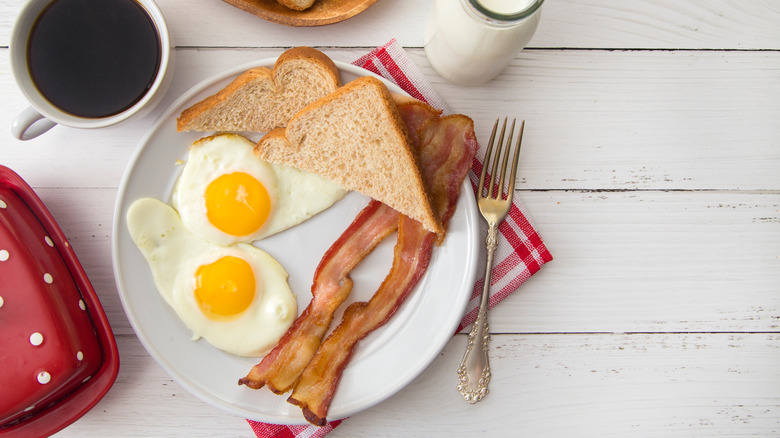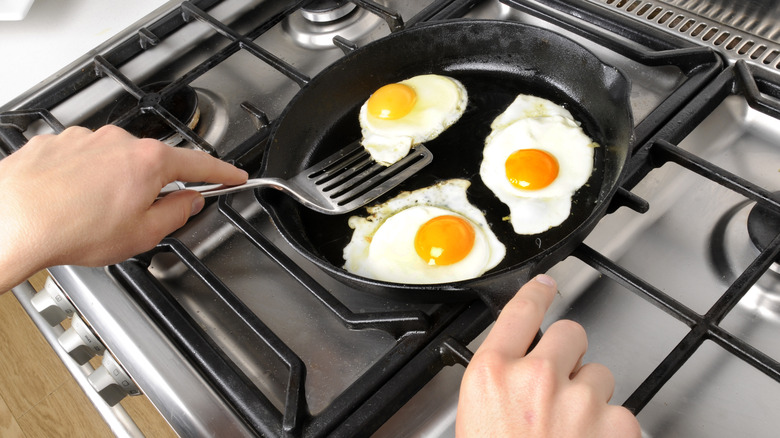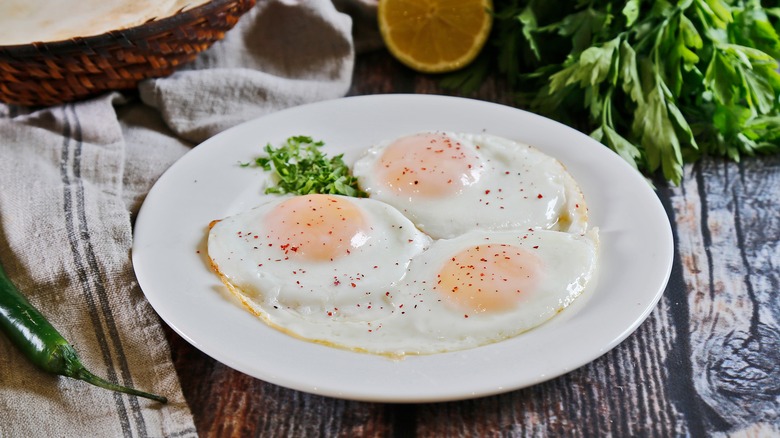The Difference Between Sunny-Side Up And Over-Easy Eggs Is One Flip
Whether you're making breakfast, or you're looking for satisfying ways to cook eggs for dinner, cooking them to order is a great way to keep everyone happy. As with steak, most people are pretty particular about how they like their eggs — whether that's scrambled, poached, over-easy to over-hard, or sunnyside up. One issue that can arise, however, is confusion over the difference between sunny-side up and over-easy. This has even been known to happen in restaurants. Go ahead and gasp! Although it shouldn't happen, it does.
Still, if professional cooks can get it wrong, then home cooks are at risk of making the same mistake from time to time. Luckily, there is an easy way to tell the difference. While both are types of fried eggs, just think of sunny-side-up eggs as cooked "up" so that only the bottom touches the pan. On the other hand, over-easy eggs are flipped to cook "easy" on the other side. After they're cooked, you can tell them apart by the bright uncooked yellow or orange yolk on the sunny-side-up egg, versus the pale layer on the over-easy egg. The yolk will remain runny with both styles, but that thin layer cooked over the yolk on the over-easy version makes all of the difference.
Cooking sunny-side up eggs
Naturally, you're going to want to start with a non-stick pan and a bit of butter, neutral cooking oil, or leftover bacon fat. While some people may swear by stainless steel, the eggs are much more likely to get stuck and rip apart when you go to serve them. Since cast iron is non-stick, a cast iron skillet will work great too — assuming you have a glass lid that fits it. Once the pan is warm and the butter is melted, crack the eggs into the skillet or pan. Just be careful not to break the yolks!
Next, place the lid on top and wait for the whites to begin to set. Once they start to do so you can remove the lid. Leaving it on too long could cause the yolk to steam, which you don't want. Continue to cook until the whites are opaque. Alternatively, you can baste the whites with the grease so that they cook faster. This will also help ensure that the yolk doesn't cook while you wait for the whites to be done.
Cooking over-easy eggs
Over-easy eggs are started the same way as sunny-side up — with a warm non-stick or cast iron skillet and plenty of fat. Butter or bacon grease will impart the most flavor but a neutral vegetable oil like canola or peanut oil works well too. It's really just a matter of taste. Since over-easy eggs get flipped, you don't have to use a lid to make sure that the whites set quickly, but you can if you want.
Once the whites are set on the bottom — which will take a couple of minutes — use a spatula to flip the eggs over. Do so carefully so as not to break the yolks. Whole yolks are imperative to both sunny-side up and over-easy eggs, after all. You don't need to wait for the whites to be completely set before flipping them since they will cook the rest of the way after doing so — but do make sure that the bottom of the pan is still well-oiled. It will only take seconds for the other side to cook, so don't leave the eggs in the pan for more than half a minute. The point is to keep that yolk deliciously runny. With all of the different ways to cook eggs, the distinction between sunny-side-up and over-easy might seem small, but the end result is worlds apart for those who have a strong preference for one over the other.



